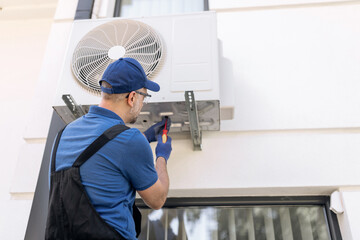An air conditioning unit is one of the most valuable appliances in a home, especially in hot or humid climates. It keeps indoor temperatures comfortable, reduces humidity, and improves air quality. But like any machine, it can develop problems over time. Knowing how to handle aircon repair issues can save you money, prevent major breakdowns, and keep your home cool when you need it most.
This guide walks through the essentials of aircon repair—from recognizing warning signs to simple troubleshooting steps—without mentioning specific brands or locations.

Understanding How Your Aircon Works
An air conditioner doesn’t simply blow cold air; it absorbs heat from your indoor space and releases it outside. It uses a combination of components—compressor, evaporator coils, condenser, fans, and refrigerant—to make this happen. When any of these parts malfunctions, the system’s performance suffers.
A basic understanding of these parts helps you identify where problems might arise and communicate more effectively with technicians if needed.
Common Signs Your Aircon Needs Repair
Spotting trouble early can prevent bigger, more expensive issues. Look out for these warning signs:
- Insufficient cooling: Warm or uneven airflow may indicate low refrigerant, dirty coils, or a failing compressor.
- Weak airflow: Clogged filters, blocked ducts, or a worn-out blower fan can reduce air movement.
- Strange noises: Grinding, squealing, or rattling often point to loose parts or failing motors.
- Unpleasant smells: Musty odors could signal mold growth; burning smells might indicate electrical issues.
- Frequent cycling: If your system turns on and off repeatedly, it may be struggling with thermostat issues or restricted airflow.
Recognizing these symptoms gives you a chance to fix issues before they escalate.
Safety First Before Repair
Before inspecting or working on your aircon, turn off the power at the circuit breaker. This prevents electrical hazards and protects the equipment. Wear gloves when handling components, and keep children and pets away from the area while you work.
Simple precautions like these make troubleshooting safer and more effective.
Simple Troubleshooting Steps
Some aircon problems can be resolved with basic maintenance rather than major repairs:
Clean or replace filters: Dirty filters restrict airflow, making the unit less efficient and potentially causing ice to form on the coils. Check and replace filters every one to three months, especially during heavy use.
Check thermostat settings: Sometimes, the issue is as simple as incorrect settings or dead batteries. Ensure the thermostat is set to “cool” and the temperature is lower than the current room temperature.
Clear the outdoor unit: The condenser unit outside can collect dirt, leaves, and debris, which block airflow. Turn off the power and gently clean around the unit. Use a soft brush or low-pressure hose to clean the fins without bending them.
Inspect air vents: Make sure furniture, curtains, or rugs aren’t blocking vents inside your home. Proper airflow improves cooling and reduces strain on the system.
More Advanced Checks
If basic maintenance doesn’t solve the problem, a deeper look may be needed:
Frozen coils: Ice on coils or refrigerant lines signals restricted airflow or low refrigerant. Turn off the system and let it thaw, then check for clogged filters or blocked ducts. If the issue persists, it may require professional attention.
Clogged condensate drain: Air conditioners remove moisture from the air, which drains away through a small pipe. Over time, algae and debris can block this line, causing water to back up and leak into your home. You can often clear it with a wet/dry vacuum or flush it with a mild cleaning solution.
Electrical issues: Loose wiring or a failing capacitor can stop your system from starting or running properly. Unless you’re confident with electrical work, it’s safest to call a technician for these repairs.
When to Call a Professional
Not every aircon repair is a DIY project. Issues like refrigerant leaks, compressor failures, or major electrical faults require specialized tools and training. Attempting these repairs yourself can be hazardous and may void any warranty.
A qualified technician can diagnose problems accurately, perform repairs safely, and ensure your system runs at peak efficiency. They can also spot potential issues you might miss, preventing bigger problems down the line.
Preventing Future Repairs
Preventive maintenance is key to avoiding costly breakdowns. By taking a few simple steps, you can reduce the need for repairs and extend the life of your system:
- Check filters monthly: Clean or replace as needed to keep airflow strong.
- Keep the outdoor unit clear: Trim back plants and maintain at least two feet of clearance.
- Monitor energy usage: A sudden spike may signal hidden issues.
- Schedule annual inspections: A routine check-up before the hot season ensures your air conditioner is ready to perform.
These habits protect your investment and improve your comfort.
Improving Efficiency After Repairs
Once your air conditioner is repaired, evaluate how it runs overall. Small adjustments can help it cool more effectively. Sealing duct leaks, adding insulation, or using ceiling fans to circulate cool air can all boost efficiency.
Improved efficiency means lower energy bills, reduced strain on your system, and fewer repairs in the future.